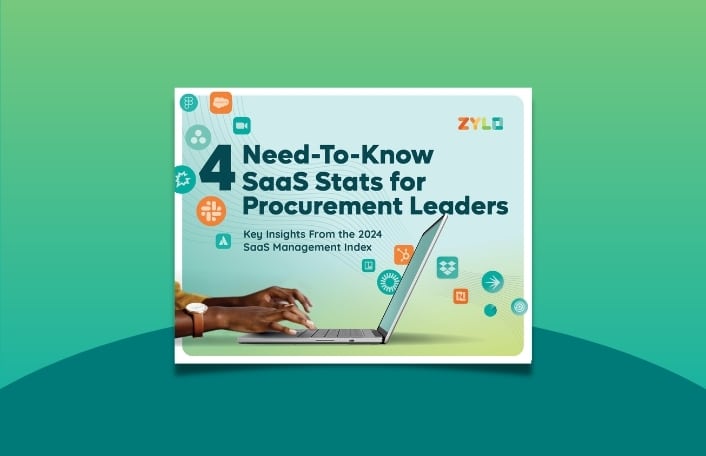
4 Need-to-Know SaaS Stats for Procurement Leaders
Ditch the Status Quo. Take Back Your SaaS Renewals. With hundreds...
Back
Back
Search for Keywords...
Blog

Table of Contents
Managing SaaS can be overwhelming, with an average of 247 yearly renewals—one per business day. Lack of time, data, and resources makes it harder to stay on top of usage and pricing. But software renewals are also an opportunity. This is the time each year when you can make changes that count, whether adjusting your needs or saving money. Operationalizing the renewal process ensures you have the information needed to act effectively.
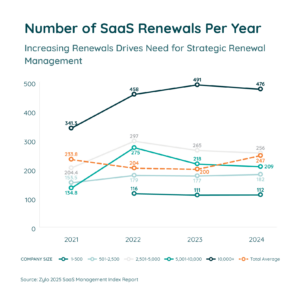
Software renewal management is more than ticking a box. It’s about optimizing costs and ensuring renewals align with your current needs and budget. By systematically tracking contracts, usage, and pricing, you can adjust your software stack and find opportunities for savings.
Without renewal management, you risk renewing licenses you no longer need or overpaying for underused software. And with the sheer number of renewals—often one every business day—it’s nearly impossible to stay on top of it without a solid strategy.
To get the most out of your software renewals, you must gather and analyze critical data points: how your team uses the software, how pricing compares to industry benchmarks, and whether the contract still fits your organization’s goals. By managing renewals effectively, you can adjust your software stack and find new opportunities for savings.
On the SaaSMe Anything podcast, Zylo co-founder and resident SaaS expert, Ben Pippenger, explains renewal management in the context of SaaS. Watch below!
Software renewals are more than routine tasks—they’re critical to maintaining business operations and controlling costs. Without a proper renewal management process, you risk unexpected expenses, missed opportunities for optimization, and even software disruptions. Adequately managing software renewals lets you evaluate each contract based on your organization’s evolving needs and budget. This means you can cut unnecessary spending, optimize usage, and avoid last-minute decisions that could hurt your bottom line.
A significant challenge with software renewals is the element of surprise. Without a proactive process, you may find yourself scrambling when a contract is about to expire. Even worse, some software automatically renews without your knowledge, locking you into contracts you no longer need. Or you may discover the renewal too late after funds have already been allocated.
Taking a proactive approach gives you time to evaluate whether the software still serves your needs and make necessary adjustments. This helps you prevent unnecessary spending and keeps you in control of your software stack.
Watch below for advice from one of Zylo’s experienced Procurement professionals for their advice on how to proactively manage renewals.
Effective software renewal management relies on having the right data. To make informed decisions, you need detailed insights into contracts, usage patterns, spending, and industry benchmarks. This helps you assess whether the tool is being used efficiently and if the contract terms still make sense.
With this data, you can confidently decide whether to renew, renegotiate, or cancel a contract, ensuring your software investments align with your business goals.
The renewal period is one of the few times you can make significant changes—scaling back licenses, renegotiating pricing, or cutting underutilized software. Each cycle presents an opportunity to find cost savings that can positively impact your budget. You can act on these opportunities and optimize your software spend by thoroughly reviewing your options.
4 Need-to-Know SaaS Stats for Procurement Leaders
Learn MoreAccurate forecasting is crucial for budgeting, and managing renewals plays a big role. Knowing when renewals are due and how much you spend allows you to better plan for future expenses. Collaborating with IT is critical, as usage data informs forecasts. By understanding how software is used, you can make more accurate spending predictions and align your budget with actual needs.
Effective software renewal management provides visibility into key metrics like spending, usage, redundancy, and renewal dates. This helps you make proactive decisions instead of reacting to problems. With clear insights into how software is used and how much is spent, you can plan effectively, address issues before they escalate, and avoid missing important renewal dates.
Renewal time is ideal for identifying redundancies in your software stack. Reviewing usage data helps you spot tools that perform the same functions or are no longer needed. It’s also important to review that on the user level, to see which users with access to overlapping tools in a specific category. Consolidating and removing redundant software can save time and money, streamline operations, and reduce unnecessary costs.
Hidden contract terms, like auto-renewal clauses, can significantly affect your budget. Removing auto-renewals gives you more control over what apps you renew, ensuring you aren’t locked into contracts you no longer need. Being proactive ensures you have time to review contracts and negotiate to remove hidden contract terms you didn’t catch the first time.
Another scenario where hidden contract terms come into play is with click-through agreements. Often, an employee buys an app and quickly clicks through, agreeing to the vendor’s terms blindly. Not only is your Procurement team unaware of these agreements, the terms favor the vendor – not your business. You’re unable to negotiate the right terms. Renewal management helps identify apps with click-through agreements so you can consolidate them into an enterprise agreement — whether new or existing.
Paying for unused software licenses is a major source of wasted spending. Zylo data shows that 53% of licenses are unused, amounting to $21M in wasted spending. Renewal is your chance to rightsize your software stack by reducing or eliminating unused licenses, saving money, and ensuring your investments match actual usage.
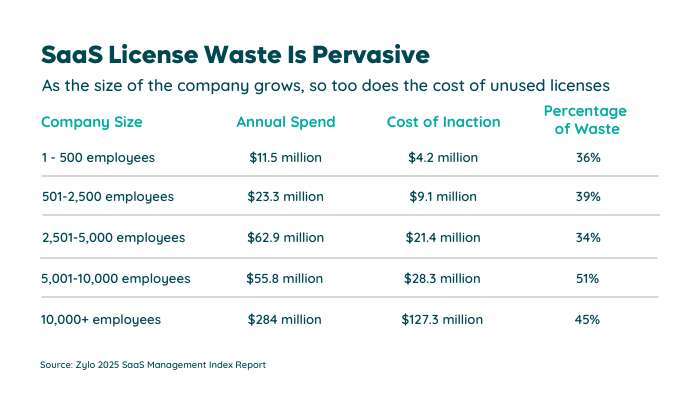
Preparation is key to getting the most out of your software renewals. Here’s a checklist of steps you can take to ensure you’re ready for each renewal period:
Keep an organized log of upcoming renewal dates to prepare well in advance. Missing a renewal deadline can lead to unwanted auto-renewals or rushed decision-making. Putting those dates in a renewal calendar makes it easy to see what’s ahead.
Work with IT, finance, and lines of business leaders to ensure everyone is aligned on the software’s value and whether it meets business needs. Collaboration helps you make more informed decisions during renewals.
Carefully go through the terms of each software contract. Look for hidden clauses like auto-renewals or pricing escalators, and be ready to negotiate better terms if necessary.
Look for opportunities to consolidate or eliminate redundant software. Reducing overlap can help you cut costs and streamline operations.
Analyze how your team is using each piece of software. Are all the licenses being used, or are there opportunities to scale back? Understanding usage patterns helps ensure you’re not paying for unnecessary licenses.
Once you understand license usage, you can use that data to get a quote from your vendor. Then, compare the pricing of your current software against market benchmarks. This will give you leverage when negotiating with vendors and ensure you’re not overpaying.
Before entering renewal discussions, be clear on what you want to achieve. Planning ensures you’re in a strong negotiating position, whether it’s better pricing, more favorable terms, or removing unused licenses.
The Ultimate Guide for Wildly Effective SaaS Renewals
Learn MoreAs you approach the 60- to 30-day window before renewal, use your gathered data to build a robust negotiation plan. With clear insights into usage, pricing, and contract terms, you’ll be better positioned to secure a favorable deal. Understanding your leverage and tactics is key to successful negotiations, whether your goal is to lower costs, reduce unnecessary licenses, or improve the terms.
Your software needs often change as your company grows. During the renewal process, assess whether your current software can scale with your business.
Before renewing, assess whether the software still meets your organization’s needs and review your company’s purchase history with the vendor. Talk with business and app owners to identify gaps or changing requirements. If the tool no longer aligns with your goals or lacks essential features, it might be time to consider alternatives that better fit your needs. Have you made recurring payments or lump-sum purchases with the vendor? Understanding these patterns can help you decide whether to renegotiate payment terms or explore a structure that better fits your cash flow needs.
Assess the level of support you’ve received from the vendor. Are they responsive when issues arise, or have you experienced delays? The renewal period is an excellent time to ensure vendor support aligns with your expectations. If not, this is the right moment to address it in negotiations or explore other vendors.
If the software has been valuable, consider using the renewal to strengthen your relationship with the vendor. Long-term partnerships can lead to better pricing, improved support, and more favorable contract terms. A strong relationship also gives you leverage in future negotiations.
Review contracts for potential risks, such as restrictive clauses or limitations that could affect your flexibility. Auto-renewal clauses, usage limits, and pricing escalators are common issues to address during renewal discussions to protect your business from future challenges.
If the software is crucial to your business and you’ve had a positive relationship with the vendor, consider negotiating a multi-year agreement. This can lock in better pricing and provide stability. Make sure the terms are flexible enough to adapt to future changes, giving you both cost savings and stability.
If usage data shows that specific licenses or features are underused, renewal is the perfect time to plan for downgrades or reduce the number of licenses. This approach can significantly cut costs, ensuring you only pay for what you need. Open a dialogue with the vendor to explore reduction options. Consider consolidating licenses into one tool if your business uses multiple tools for similar tasks. License consolidation reduces redundancies, improves efficiency, and cuts costs — and renewal time is ideal for making these adjustments.
The renewal period is your key opportunity to assess SaaS contracts and make adjustments. You can renegotiate terms, eliminate redundancies, or reduce costs. Asking the right questions helps you decide whether to renew, renegotiate, or move on from a software tool.
License waste is a big issue, especially when over half of software licenses go unused. Analyzing your usage data is essential to determine whether the software still provides value or if it’s time to reduce licenses.
Understanding what the vendor values in negotiations can help you secure better terms. Are they focused on long-term contracts or upselling features? If a multi-year agreement appeals to them, use that leverage for discounts or improved terms.
Redundancies in your software stack increase costs and inefficiencies. For example, companies average 15 apps for online training, 10 for project management, and 10 for team collaboration. Consolidating overlapping tools into one solution could streamline operations and cut costs.
Before renewing, evaluate how the software performs compared to other available solutions. Does it help you meet your business goals? It may be time to explore alternatives if newer options offer better features, efficiency, or pricing.
Vendor support is critical. Are issues resolved promptly, or do delays persist? If the support hasn’t met your expectations, renewal time is a great opportunity to renegotiate terms or explore new vendors for better service.
Review all the software tools purchased in the past year. Identifying any overlapping functionality ensures you’re not renewing licenses for redundant or unnecessary tools.
Evaluate your actual software needs. Have business requirements evolved? Do certain tools still provide value, or are they outdated? This is the time to refine your technology choices based on current goals.
Renewal time is ideal for exploring alternatives that offer better value, enhanced functionality, or scalability. Assessing alternatives ensures your software investments align with your long-term strategy.
Managing software renewals effectively requires a clear strategy. These best practices help ensure your renewal process is streamlined, cost-effective, and aligned with business goals.
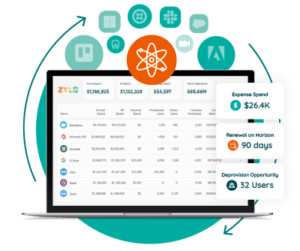 Visibility is crucial to managing renewals. You need clear insights into your apps, contracts, spending, and usage to make informed decisions. Shadow IT can slip through the cracks without full visibility, making it easy to miss renewals or cost-saving opportunities. Centralized tracking ensures nothing important is overlooked.
Visibility is crucial to managing renewals. You need clear insights into your apps, contracts, spending, and usage to make informed decisions. Shadow IT can slip through the cracks without full visibility, making it easy to miss renewals or cost-saving opportunities. Centralized tracking ensures nothing important is overlooked.
Accurate renewal dates, spending, and usage tracking are critical to making informed renewal decisions. Tools like Zylo’s Dashboards and automated Insights track this data in real time, helping you identify opportunities to optimize your software stack and reduce unnecessary costs.
A well-maintained renewal calendar helps you prioritize contracts and keeps you ahead of deadlines. A well-organized renewal calendar that integrates into your workflow will alert you when renewals are approaching. Now, you have time to plan and stay on track.
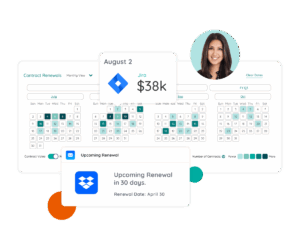
Engaging application owners and business leaders is crucial for a successful renewal process. Regular communication and training ensure everyone understands the renewal strategy and their roles. This collaboration helps assess whether the software continues to meet the company’s needs.
Auto-renewals can ensure continued software access but may also lock you into unnecessary contracts. Track auto-renewal clauses in your contracts and set alerts to review them before renewal dates. In some cases, removing auto-renewal clauses allows you to reassess your needs before committing to another term.
Aligning your renewal strategy with business goals is vital to driving cost savings and efficiency. Whether you aim for savings or operational improvements, setting clear goals for each renewal ensures your software stack remains aligned with those objectives. These goals also guide decisions on what to renew, cancel, or modify.
Operationalizing your renewal process is critical to staying proactive. Setting milestones at 30, 60, 90, and 120 days ensures that renewals are managed well in advance. This approach allows thorough preparation, including reviewing contracts, assessing usage, and engaging stakeholders early.
Building strong vendor relationships is valuable when preparing for renewals. Partnering with vendors and internal stakeholders like IT and application owners ensures you get the support and flexibility you need. These relationships can also give you leverage during negotiations to secure favorable terms.
Regular reviews with app and business owners keep renewals on track. These check-ins help determine if the current software meets their needs or if concerns need to be addressed before renewal. Regular audits ensure contracts and app ownership stay aligned with evolving company goals.
To understand the importance of holding the reviews and having conversations with app owners, listen to our interview with Karen Hodson, Global Procurement & Real Estate Officer at Marigold.
Managing software renewals effectively requires the right tools to streamline processes and provide valuable insights. Solutions like Zylo help organizations stay ahead of renewals, optimize usage, and improve vendor relationships while cutting costs. Here’s how Zylo supports your software renewal strategy.
You need to get the right data to the right people at the right time. Automated Reports provide stakeholders with up-to-date information on software usage, spending, and contracts, ensuring informed decisions well before renewal deadlines. Automated reports simplify the process and prevent missed opportunities.
Keeping stakeholders informed about renewals to avoid last-minute decisions. Zylo’s Automated Alerts notify teams about critical dates, missing contracts, and renewal tasks. This ensures no renewals slip through the cracks, and that everyone is prepared with the necessary information.
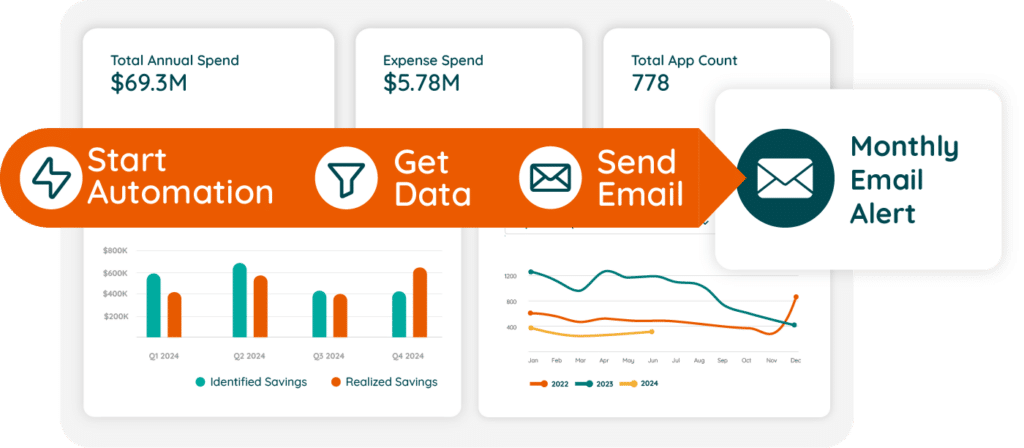
A SaaS Management Platform (SMP) offers access to detailed data, making vendor negotiations easier. Procurement and IT teams can confidently approach negotiations, armed with insights into usage, spending, and contract terms, helping secure better deals and optimize relationships.
One significant benefit of renewal management is optimizing software licenses. Zylo’s Insights reveal underused licenses and track spending, allowing businesses to reduce or consolidate licenses. This allows you to only pay for what’s necessary, saving on costs. Cost Allocation helps drive accountability at the department level to optimize usage and spending.
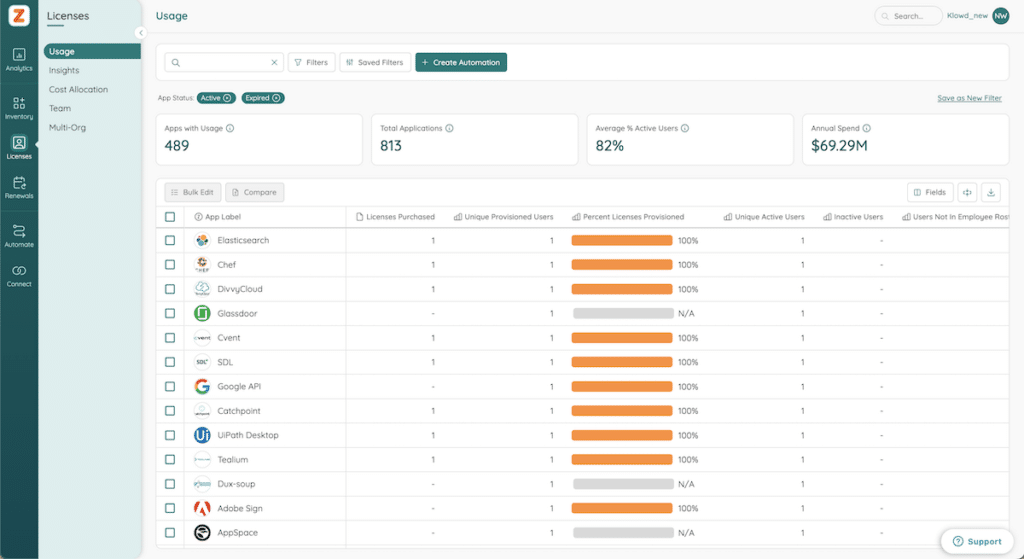
Effective renewal management requires centralized access to all software applications, spending, contracts, and usage data. Zylo serves as a SaaS system of record, bringing everything into one place. It provides Procurement with all the tools needed for holistic renewal management, from tracking usage and renewal dates to accessing contracts.
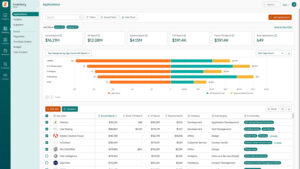
Organizing contracts is critical to renewal management. Zylo’s Contract Center simplifies storing, accessing, and updating contracts, ensuring you always have the most current documentation. This reduces administrative burden and makes contract management more efficient.
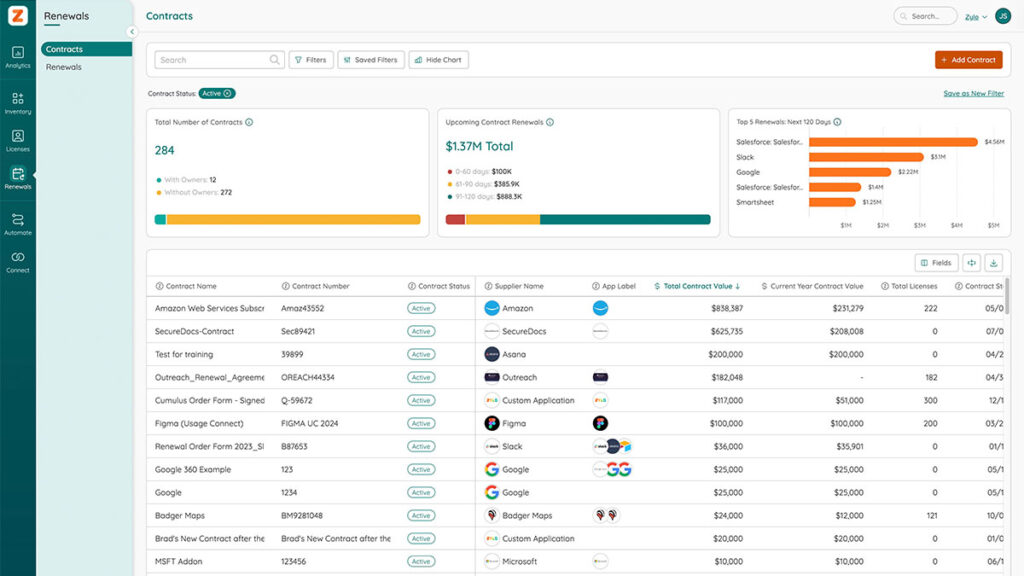
Accurate forecasting helps you manage renewal budgets. Zylo’s Cost Allocation helps you allocate costs to the right departments and track spending over time, ensuring renewal decisions align with budgeting goals and forecasts.
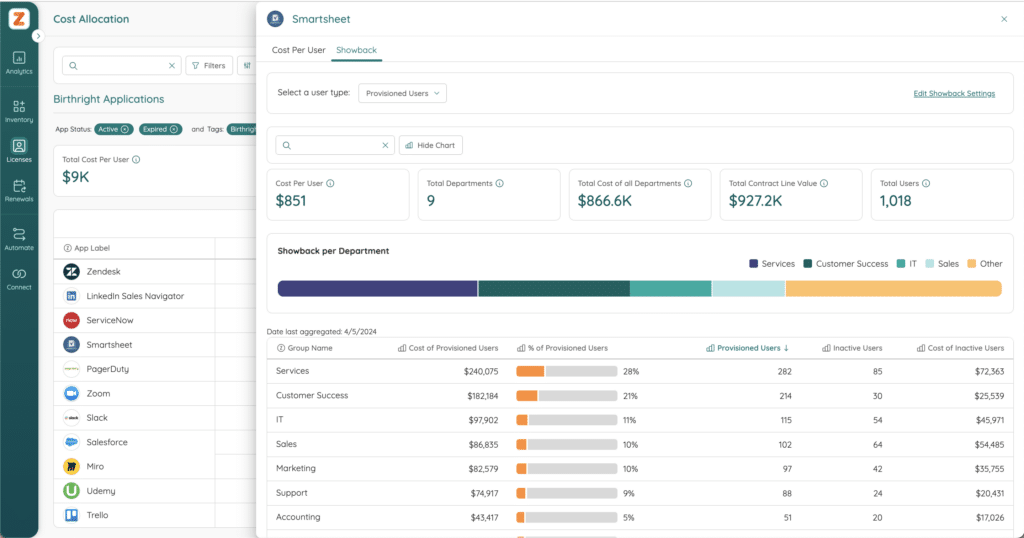
Visibility across your software portfolio is essential for managing renewals effectively. Zylo offers an AI-powered discovery engine that finds all the SaaS lurking within your organization. Then, Zylo’s Dashboards provide a comprehensive view of usage, spending, and contracts, making it easier to prepare for renewals and track all renewal-related activities.
Understanding how your software performs over time is crucial for making renewal decisions. Zylo’s Usage Insight offers app-level detail, allowing businesses to monitor performance, spending, and potential savings. This helps identify underperforming tools and ensures renewals focus on high-value software.
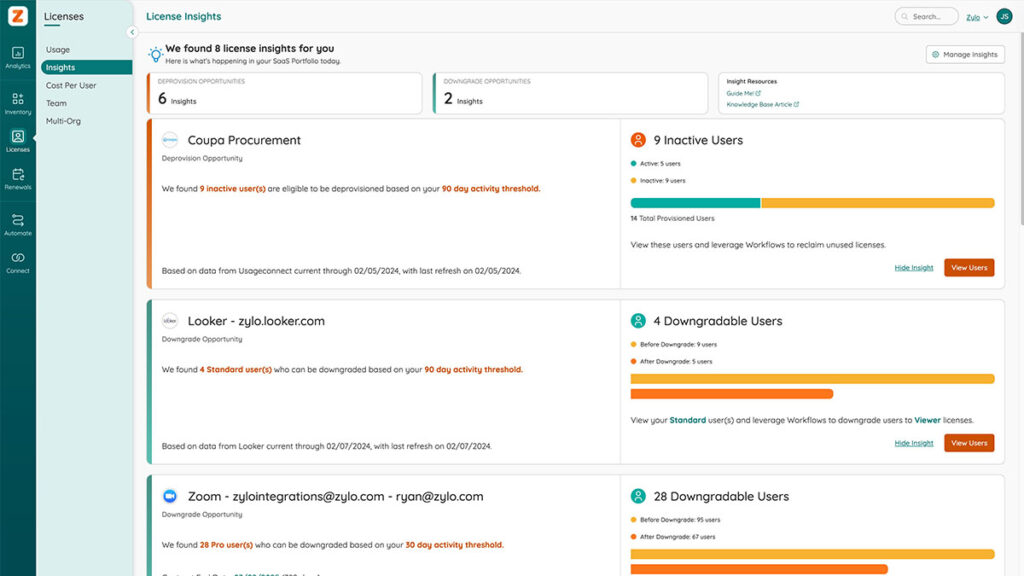
Zylo helps businesses operationalize renewal management by integrating milestones and tasks into existing workflows. With 30-, 60-, 90-, and 120-day milestones, Zylo ensures proactive renewal management and keeps your process efficient.
Because savings is a key outcome of renewal management, you need to keep track of those savings and measure them over time. Zylo’s Savings Center automatically tracks savings events, helping you see savings over time and highlight avoided costs. This provides the transparency leadership needs to understand the value of this method and ensures you can celebrate every win while keeping stakeholders informed.
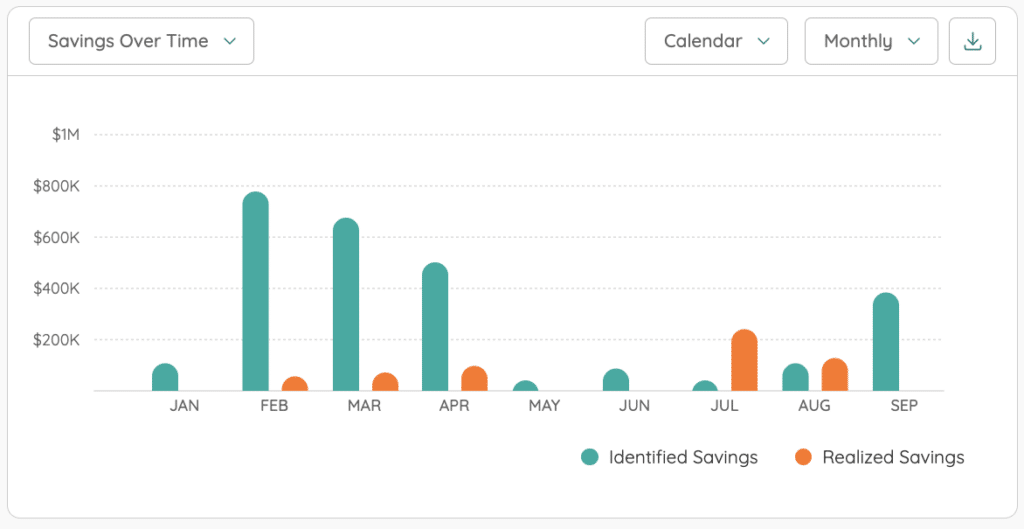
Managing renewals effectively is critical for optimizing investments and reducing costs. Zylo’s comprehensive SaaS Management Platform brings spending, usage, and contract data into one place, ensuring you’re ready for every renewal. Contact Zylo today to learn more about streamlining your renewal process and optimizing your SaaS portfolio.

Ditch the Status Quo. Take Back Your SaaS Renewals. With hundreds...

Discover how Marigold unlocked the door to nearly $1M in SaaS cost savings with Zylo, while undergoing a M&A tech integration and cutting software waste from their portfolio.
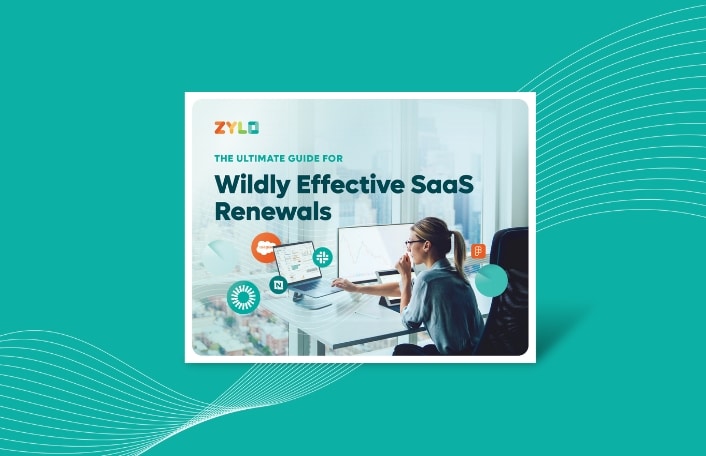
Do SaaS renewals make you feel like your hair’s on fire?...
| Cookie | Duration | Description |
|---|---|---|
| cookielawinfo-checkbox-analytics | 11 months | This cookie is set by GDPR Cookie Consent plugin. The cookie is used to store the user consent for the cookies in the category "Analytics". |
| cookielawinfo-checkbox-functional | 11 months | The cookie is set by GDPR cookie consent to record the user consent for the cookies in the category "Functional". |
| cookielawinfo-checkbox-necessary | 11 months | This cookie is set by GDPR Cookie Consent plugin. The cookies is used to store the user consent for the cookies in the category "Necessary". |
| cookielawinfo-checkbox-others | 11 months | This cookie is set by GDPR Cookie Consent plugin. The cookie is used to store the user consent for the cookies in the category "Other. |
| cookielawinfo-checkbox-performance | 11 months | This cookie is set by GDPR Cookie Consent plugin. The cookie is used to store the user consent for the cookies in the category "Performance". |
| viewed_cookie_policy | 11 months | The cookie is set by the GDPR Cookie Consent plugin and is used to store whether or not user has consented to the use of cookies. It does not store any personal data. |
